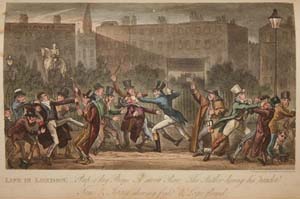Printing and Publishing

Color plate books represent a unique period in publishing history. The two most common techniques used in the production of these books were aquatint and chromolithography. The years 1790-1830 were the great period of colored aquatint illustration and the golden age of colored books in England. This is the period emphasized in this exhibition. Lithography, in contrast to aquatint, became popular in Britain only after Rudolph Ackermann published A Complete Course in Lithography in 1819, and chromo- (or colored) lithography was not invented until 1837. In the early decades of color plate books, color was usually added by hand, although the advent of chromolithography made this unnecessary, as color could be reproduced in the printing process. It was the advent of chromolithography, which allowed color to be be printed as opposed to added by hand, that made possible the explosion of color in Victorian book illustration. This appetite for color illustration was one which had been whetted by color plate books.
